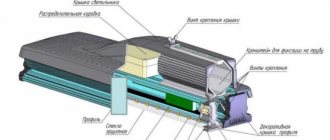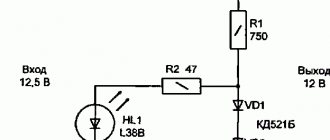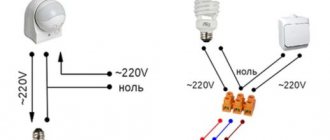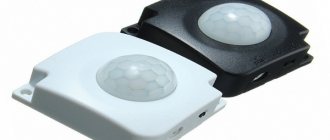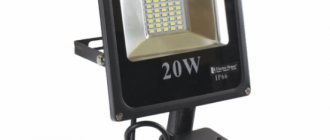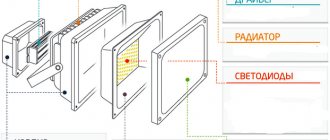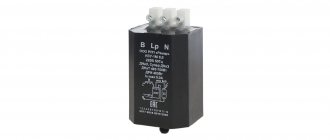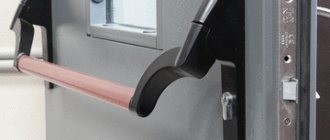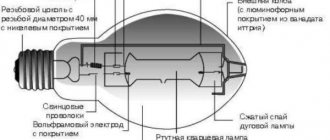There are certain requirements for such lamps that provide street and industrial lighting, illumination of transport routes and structures - a high level of color transmission and contrast of illuminated objects. These requirements are based on the safety conditions when performing work in these areas.
Currently, many organizations are switching in outdoor lighting from the use of gas-discharge lamps to the use of LED analogues. To correctly understand when and where it is appropriate to replace DRLs with LED lamps, you need to consider their characteristics.
Gas discharge and LED lamps: comparison
Replacing DRL lamps should not be carried out with a loss of quality lighting; to do this, you need to understand what parameters affect illumination when choosing a lamp: luminous flux, the value of which is measured in lumens (lm), and the second indicator for the characteristic - how many lumens are per 1 W lamp .
Light sources also differ in temperature; there is warm and cold light, the difference is shown in the photo:
In order to choose the right lamp, you need to understand how the luminous flux is calculated. To make things easier, you can use the formula:
- for LED sources - power × 80 lm/W;
- for DNAT (power 250 W) × 88 lm/W;
- for DRL (power 250 W) × 58 lm/W.
The luminous flux for gas-discharge light sources, measured in this way, can only be correct if the lamps operate for no more than 12 thousand hours, then the glow intensity drops.
DRL lamps
Let's consider DRL 250. This type of lamp is easy to produce compared to fluorescent light sources, but has worse color rendering of the illuminated object and light output compared to sodium devices. The advantage over HPS is the absence of high-voltage devices in the switching circuit, as well as better energy consumption parameters: they are more economical, there is less pulsation of the light flux.
DRL light source
HPS lamps
This type of lighting device is characterized by good luminous efficiency, regardless of the duration of operation of the lamp. Experts do not recommend using these light bulbs inside production facilities to illuminate large spaces due to the high pulsation of the light flux, as well as the deviation towards the red color of the emission spectrum - together, this affects the color perception of lighting objects.
Effective operation of sodium arc lamps is possible only under certain conditions:
- stable network voltage;
- lamp operation in the temperature range from –20 to +30 °C.
When luminaires with these lamps are used in other conditions, experts note a significant decrease in luminous efficiency and a decrease in the service life of lighting devices. This type of device depends on the quality of the triggering elements and the internal pressure.
If we consider the issue of replacing DRL with HPS, it can be noted that many consumers form the erroneous opinion that the illumination of the space will become better, and this will be a more economical option, since they do not take into account the fact that replacing DRL with HPS of the same power , you thereby increase the amount of current consumed. It is also necessary to take into account that sodium light sources distort the color rendering of the illuminated object; According to experts, for this reason they cannot be installed on lamps along highways.
HPS lighting source
High power LED lamps
An analogue of DRL 250, according to experts, should be sought in innovative LED lamps, which have a high efficiency of up to 98%. A high-efficiency LED lamp is an energy-saving device with the property of low thermal output.
The technology for producing light radiation provides LED lamps with additional characteristics:
- resistance to temperature fluctuations;
- resistance to mechanical stress;
- insensitivity to power surges;
- they have excellent color reproduction of the illuminated object, a long period of effective operation;
- no flicker of light;
- have a positive effect on the environment, being a product of modern technologies.
In order to use this type of lamps at production facilities and for illuminating large areas, they are produced with a power of 20 to 150 watts. It is characteristic that the greater the power of the LED lamp, the more additional properties they have. Lamps with power over 60 W have their own cooler, and lamps over 110 W have an electrical power driver.
LED device, LED lamp
Comparison table for DRL, HPS, LED lamps:
| Options | DRL | DNAT | LED lamp |
| Lamp type | 250 | 250 | To replace DRL 250 |
| Power (watt) | 250 | 250 | 80 |
| Power consumption (watt) | 280 | 290 | 80 |
| Service life (hours) | 12 000 | 15 000 | 50 000 |
| Luminous flux (lumens) | 13 000 | 24 000 | 7 500* |
*The level of 7,500 lm, according to experts, provides illumination similar to a 250-watt DRL lamp; this is determined by the direction of the light flux emanating from the LEDs.
From the illumination of the object it is clear that with a luminous flux of 13 thousand lumens, the object actually illuminates no more than 9 thousand lumens. This is due to the loss of luminous flux on the lamp reflector. If we take into account the fact that with the same consumption of electrical energy, the glow of DRL 250 lamps decreases by half, then an analogue of 7,500 lumens of an LED lamp is quite sufficient.
An analogue of DRL 400 in the LED version can be the “Module” lamp, which has a power of 128 watts and consists of two assemblies of 64 watts each. The luminous flux of this device is 16,000 lumens, the operating capacity is 100,000 hours.
Characteristics
The power of DRL lamps is on average 700 watts, the rated current is 12 amperes, the voltage is 140 watts, and the light output is 40,600 lumens. Base type E27 and E40, maximum diameter 152 mm. The average service life is 4000 hours.
As for the technical characteristics of DNAT, in addition to the topic, replacing drl with dnat, it is worth pointing out that the service life with operating temperature is 25,000 hours and 40 degrees, respectively, the base thread type is E27, power consumption is 1000 watts, voltage is 120 volts, light flux - 130 thousand lumens, light output - 130 lumens per watt, wavelength - 640 newtons per meter, and light flux pulsation 70%.
You may be interested in this Features of fluorescent lamps
Specifications and comparison
Efficiency of using DRL, HPS and LED lamps
When organizing the illumination of a large space, one must always proceed from the correct use of lamps, taking into account the conditions of their use.
- DRL lamps are easy-to-use devices that are affordable; it is advisable to use them on objects without special requirements for the quality of illumination.
- Sodium arc lamps have the best luminous efficiency in the category of gas-discharge lighting sources, but have a low level of color rendering and are temperature dependent. For these reasons, they cannot be used in production workshops or on roads. In other places, the use of this type of lamp is permitted.
- An LED (LED) lamp has one drawback, according to experts - the need to create a heat sink from the light diodes, since possible overheating during operation can affect the crystal with the phosphor. In addition, the power source (driver) of this type of lamp contains capacitors, the operation of which is limited to a time interval of 6–10 thousand hours; after this period there are no guarantees of high-quality lighting. Modern LED lamps use solid-state drivers, which makes it possible to increase the lamp operating time to 50–60 thousand hours.
Outdoor lamp with a solid-state driver
An LED lamp, unlike gas-discharge light sources, does not require a starting current, which affects the choice of wire cross-section when connecting it. It should be noted that LED lamps are currently expensive. The payback for one lamp occurs within a year of its operation when burning for 8–10 hours during the day.
Sodium or LEDs? The choice is obvious!
What benefits await the consumer when replacing an old DRL lamp with an LED analogue? It should be noted that sodium gas-discharge lamps (HSD) have a number of advantages that cannot be ignored. This is a very high luminous flux and a long service life. In these parameters, although today they are inferior to their LED counterparts, they are only insignificant compared to other types of lamps. Thus, the luminous efficiency of HPS lamps ranges from 70 to 100 lm/W. (sometimes up to 150 lm/w), and the average service time is 12,000 hours.
LED lamps, with similar light output, last approximately 4 times longer. But there are nuances here that the consumer should not forget about. Thus, the luminous output of a HPS lamp on average decreases by 50% after just 2000 hours of operation, while for LED lamps this figure is only 30% after 50,000 hours. Agree, the difference is noticeable.
Conclusion
When choosing a lighting device to illuminate an object, one must take into account the fact that DRL and HPS can exhibit an “aging effect” when the luminous flux dims over time. Experts determine the beginning of this period after 400 hours of operation of this type of lamp; they begin to shine at 80% of the declared luminous flux power, and then the glow decreases to 50%.
Today, LED lamps, despite their cost, are increasingly used in lighting large spaces. Taking into account the payback time and duration of operation, they make it possible to save on electrical energy.
Best prices for LED lamps with E40 base
You can buy LED lamps at a good price in our store. We offer you an assortment of light bulbs of various shapes, so you can easily find a lamp for any lamp, even the most exclusive one.
E40 LED lamps do not pulsate; models are available with different color temperatures. The design of the lamps includes a powerful radiator to lower the temperature of the LEDs and, as a result, increase their service life. They are usually made in a “vandal-proof” case with a high IP rating and work perfectly at temperatures from -40 to +50 degrees, which is important when used outdoors. All of them do not contain toxic substances and do not require disposal.
Replacement of DRL 125 and DNAT 70-250 watt lamps in industrial luminaires
HPS lamp
— general information.
High-pressure sodium HPS lamps are one of the most economical energy sources today.
Their widespread widespread use confirms this fact - DNAT lamps of various wattages are used, as a rule, for street lighting, including lighting of transport highways, tunnels, stations, airfields, industrial areas, that is, almost everywhere. Another common area of application for a HPS lamp is lighting in greenhouses, flower beds or plant nurseries. The abbreviation DNaT itself stands for “sodium arc tube lamp.” The design and operating principle of a HPS lamp are quite simple. In the outer glass cylinder of the HPS lamp there is a special “burner”, which is a cylindrical discharge tube made of a special material - pure aluminum oxide. The tube is filled with a mixture of sodium and mercury vapor, and the igniting gas xenon is also present. An electrical discharge (arc) is created in high-pressure sodium vapor. In this case, a HPS lamp, as a rule, has a specific emission color with a golden-white or orange-yellow tint. Application
Power is the most important technical characteristic of a DNAT 250 lamp - the choice of lamps of a certain power must necessarily correspond to the scope of its application. It is known, for example, that the HPS 250 lamp is very effective in the case of artificial lighting of greenhouses, flower beds, and plant nurseries (but such lamps should in no case be placed closer than 50 cm from the plants). More powerful lamps are dangerous to install in greenhouses and flower beds - they can simply burn the plants. As for lighting streets, underground passages, and indoor sports complexes, a HPS 150 lamp or a HPS 70 W lamp is usually used for these purposes. It is also important to consider the degree of protection of lamps from dust and moisture: LED lamps with IP 65 are suitable for street lighting.
[good:07102,N70052,N70051,47314,162023,161483,161473,47826,161381#fgdfgdffdh31]
Mercury arc lamps type DRL
— high-pressure gas-discharge mercury lamps, used for street lighting and lighting of large production areas.
DRL lamp
tends to flare up for a long time - within 7 minutes. When you turn off such a device, you cannot turn it on again until the lamp cools down, this is its significant disadvantage. Also, the lamp is highly sensitive to ambient temperature, for this reason the design has an additional outer glass bulb.
Application
Lighting of open areas, industrial, agricultural and warehouse premises.
Today to replace DRL
and
HPS,
with E40 socket on sale .
Powerful LED lamps can be used in outdated lamps without the use of additional equipment. The housing of the E40 LED lamp is made of impact-resistant plastic and an aluminum radiator, designed specifically to remove the heat generated by LEDs.
Another huge advantage is the presence of a special lens that is designed to increase the lighting angle.
Thanks to the lens, the lighting angle reaches 140 degrees, which makes such lamps very practical and convenient for illuminating streets, parks, railways, courtyards, as well as busy highways and other open areas. Such a lens ensures that electricity is consumed exclusively for its intended purpose, for lighting. And this is very important, because with alternative lamps, a significant part of the electricity is mainly spent on heating the base, which is completely unnecessary. As for the lighting mode, it is quite comfortable, well provided by these LED lamps, due to the increased color rendering coefficient when compared with sodium lamps, as well as due to the complete absence of any flicker. [good:07102,N70052,N70051,47314,162023,161483,161473,47826,161381#fgdfgdffdh32]

